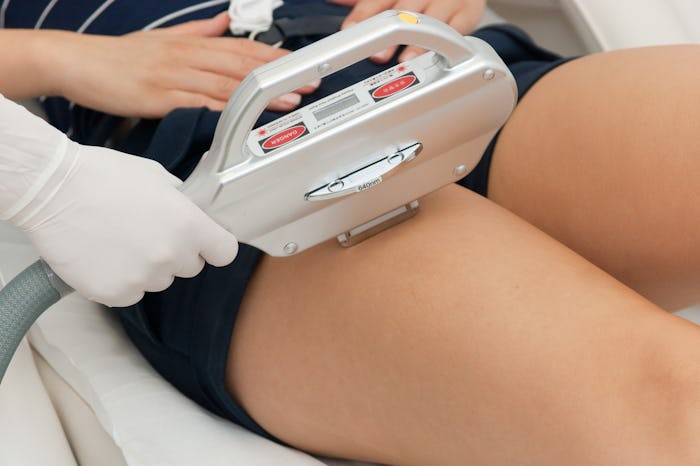Life

The Hair Removal Tricks Dermatologists Wish You Knew About Don't Even Involve A Razor
It is a truth universally acknowledged that once a girl reaches an age where she grows body hair, she's going to need some hair removal tricks, especially when you consider she will spend roughly the next 60 years of her life removing it over the course of 60 days, according to a survey by American Laser Centers. At an average of $15.87 per month that accumulates to about $10,000 over the course of her lifetime, the report continued, it's safe to say that one of the more easily achievable beauty standards — hairless skin — still exacts a pretty steep toll on adult women whose bodies are functioning exactly the way nature intended. Visiting a dermatologist to remove it permanently may seem like an unnecessary luxury when a quick swipe of the razor is practically an afterthought, but there are some hair removal tricks doctors wish you knew about that will save you time and money.
According to New York City-based dermatologist Dr. Debra Jaliman, many people in her practice decide to take the plunge of a professional hair removal once the discomfort and inconvenience of shaving become too much. "Shaving too often in one spot can cause irritation, and hair returns very quickly," she writes in an email to Romper. "After years of shaving and throwing money away on razors, shaving gels, and years of painful waxing, they make the decision to undergo a hair removal procedure."
So what is a hairy, tired lady to do? The most popular option in Dr. Jaliman's office is laser hair removal, of which there are several types, but they all work in the same way. Using a beam of light, a medical professional targets the more darkly pigmented hair follicle beneath the skin to inflict enough damage so it no longer produces a hair. This procedure works better on some skin tones than others, but practically all complexions can benefit from different varieties of lasers.
"The best results are from patients who are light-skinned and have dark hair. However, it can be used on darker skinned patients as well," Dr. Jaliman says. "Laser hair removal can achieve permanent hair reduction, but it cannot be guaranteed in all cases. Some patients will need to have the areas retreated every so often for maintenance as they see the hair return."
According to the skincare resource Paula's Choice, the cost can vary widely between $150 to almost $1,000 per session and at least six trips will be required to blast out those hair follicles permanently.
What if you want professional help, but devoting the time, money and fortitude to zapping your skin doesn't really appeal? Prescription creams like Vaniqa can inhibit facial hair growth to increase time between waxing trips, Dr. Jaliman says. According to the cream's website, Vaniqa works by inhibiting the production of a crucial enzyme for hair growth, and patients will see improvement after six to eight weeks of twice daily use.
"(Creams) can be used in conjunction with any hair removal technique already being used to achieve better results," says Dr. Jaliman. "This is a good option for someone who doesn't want to spend money on laser treatments or other hair removal procedures."
Unfortunately, there are no lifestyle changes you can undertake to inhibit hair growth, Jaliman says. Since hair is just dead protein exuded through the skin, its nature is determined by genetics and hormonal factors. If slowing down hair growth on your body is what you're after, Jaliman says prolonged threading or waxing might do the trick. Because the hair is removed further down the shaft, results from these two removal methods last longer, and the hair follicles may be damaged enough over the course of time that they stop producing strands. But effective, reliable, and lasting results can be found in the dermatologist's office under the beam of a laser.